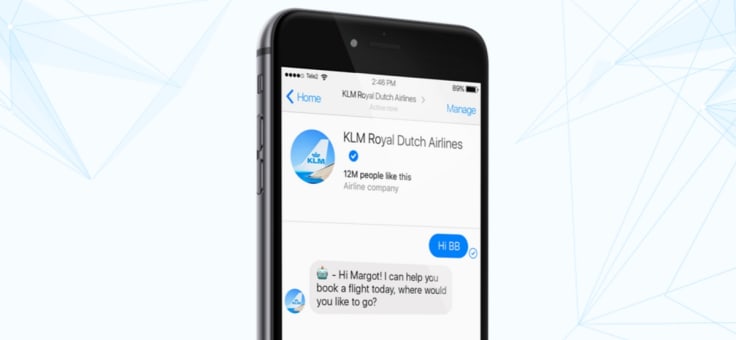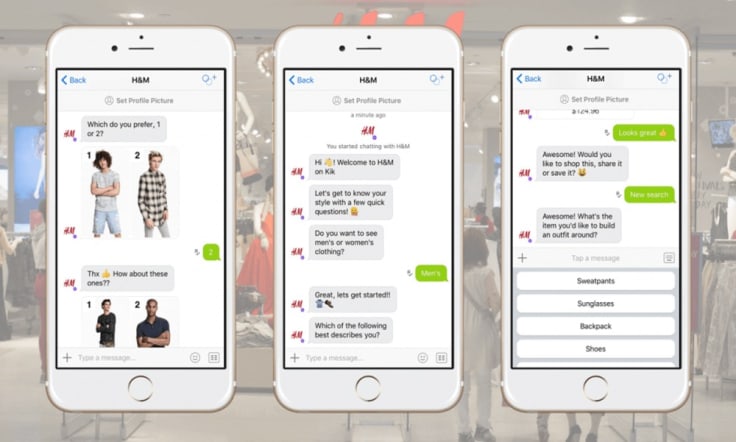Showing top 0 results 0 results found
Showing top 0 results 0 results found

Millennials show a strong preference for self-service options and the ability to handle customer service issues themselves. Businesses have known this for years and have sought new ways to meet this demand.
AI Chatbots are ideal for providing the fast, personalized self-service millennial consumers expect. Not only do they offer a faster and easier alternative to other customer support channels, but they are also well-suited to support voice-activated searches, purchases, and customer service interactions, which are on the rise thanks to the widespread use of AI assistants such as Amazon’s Alexa or Google’s Home.
So how are brands using the benefits of artificial intelligence chatbots to engage millennial customers?
Looking for ways to connect with more millennials?
Millennials want more self-service options
More than half of millennials say that they prefer to use customer service automation over live support from a human representative when given the option. This means that improving your self-service resources is a surefire way to improve your customer experience for millennials.
Detailed tutorials, online courses, troubleshooting guides, and FAQs are valuable tools for customers trying to solve a problem without contacting you but are not always ideal for those users who are in a hurry and need a quick answer.
A chatbot can make this information more accessible and simpler to digest and provide a more effective search method for the resource they need. When tackling a technical issue, users who do not know the right technical terms to describe their problem may have difficulty finding relevant information.
An artificial intelligence chatbot can help them narrow their issue through simple questions they do not need technical knowledge to answer.
Immediate response
Nobody likes to wait, but millennials are more demanding in this regard. Their distaste for waiting has been apparent in studies and statistics for years, and as a result, they are more likely to make purchasing decisions based on how quickly they can get things done with your business. 82% of customers say that issue resolution time is the single most important factor in providing excellent customer service.
Chatbots can provide an instant response to many different types of customer queries, from requests for technical support to managing account information and settings or even making purchases and bookings. Handling these actions through a chatbot means users don’t have to spend time searching your site or app for what they are looking for or a solution to their problem. This helps prevent users from giving up out of frustration and boosts the customer experience.
A 5% increase in customer retention can boost your sales by up to 95%, making this a valuable consequence of introducing a chatbot to your service.
Improve overall response times
60% of millennials think they should have to wait less than 5 minutes to speak to someone on a customer service line. This is a challenging expectation to meet for many businesses. Reducing the number of incoming calls is a vital strategy for achieving a response time like this. Your average first response time across all channels is a vital metric to manage, as it can have a significant impact on the customer experience and overall trust in your company.
Chatbots provide an instant response to customers who are using them to get help or answer queries. However, they also speed up response times for people using your other customer service channels.
This is because offering the opportunity to get an instant response from a chatbot reduces the strain on other customer service channels that have the bottleneck of needing live agents to help customers.
Millennials (and Generation Z) are more willing to use chatbots and other self-service options than other demographics, resulting in fewer support tickets being created that need the attention of a live agent. 70% of millennial consumers prefer to communicate with brands using text-based channels such as chatbots, live chat, and SMS.
Consequently, your overall support response times will be faster even for customers who do not use the chatbot, and you can use your customer service resources more efficiently by offloading many requests to an automated channel.
As a result of these factors, chatbots are an ideal tool for handling spikes in customer service requests without a drop in response times, such as those that can occur due to a service outage or a seasonal event.
For example, chatbots can help reduce the load on first-line support teams during Black Friday sales, creating a better experience for your customers and reducing your costs in recruiting and training seasonal support staff.
In fact, the average US business could save up to 30% of its operational costs by using a chatbot to handle customer service queries. Event organizer Slush uses their Jenny chatbot to successfully automate 64% of all incoming customer support contacts, helping them to manage the increased demand in the lead-up to their next event.
In-app or on-site support
Chatbots let you offer a communication and support channel that doesn’t require users to leave your website or app. Instead, they can get help at the tap of a button while staying on the part of your site or app they need assistance with. This means they can get a faster resolution to their issue and that there is no need to create a support ticket or send an email that will take time for a live agent to respond to.
Furthermore, providing help and guidance through an in-app chatbot has many practical benefits for assisting customers. For example:
- Users have already logged into their accounts and passed security measures. As a result, they can avoid the hassle of logging in or creating a new support account to get help. It also means the chatbot can reference and link to account information within the conversation.
- The chatbot can guide users through specific actions or even perform them for the user.
- Users can start getting help when they encounter a problem without waiting for additional work.
AI-driven personalization
Millennial consumers are at the forefront of demanding more individualized, personal experiences from the companies they do business with. Offering personalized content and experiences increases brand loyalty among millennials by an average of 28%. They want businesses to communicate in ways that suit them, anticipate their needs, and consider their preferences. Chatbots can meet all three of the millennials' demands.
AI-powered chatbots use natural language processing to understand customer queries better and interpret and match their tone, creating conversations that feel more personal. Machine learning also enables chatbots to analyze user input and past interactions better to predict customer needs, creating a more proactive and helpful self-service option.
The ability to provide answers and recommendations on a more individual basis helps chatbots bridge the gap between self-service and live support options.
For example, KLM Airlines uses its BlueBot chatbot to let customers book journeys through natural conversation, asking questions and understanding the intent behind customer answers to make the booking process more hassle-free.

Similarly, fashion brands like H&M use chatbots to connect with mobile customers, asking questions about what they are looking for to provide recommendations that match their style.

Useful on any device
One of the reasons businesses create such a wide range of support resources is that not all customer support tools are as useful on every device or in every situation. For example, people cannot always watch or listen to a video guide or might not want to read a lengthy tutorial on a small phone screen.
However, millennials expect to have a full range of options when interacting with your business, no matter the device they are using. The chatbot technology is ideal for meeting this expectation, as it can provide useful assistance with minimal input from the user, even prompting them with topics and questions to select at the tap of a button, so there is no need to type. They even support the growing use of voice-activated devices to conduct business online.
Voice support
Artificial intelligence chatbots are a great way to extend your site or app’s support for voice-activated searches coming from home assistant devices like Amazon Alexa. Millenials and Gen Z consumers are already browsing and shopping online by speaking on their home devices. However, this seamless experience breaks down if they have to switch to a different channel to get support.
While sending an email or creating a support ticket using a voice assistant is possible, it is far from quick or convenient. While these virtual assistants can perform an impressive variety of functions, a chatbot dedicated to supporting your business can do far more than an assistant like Siri, which cannot interact with any of your backend systems to perform actions or find information for the user.
Enabling voice users to speak to a chatbot instead lets them communicate more directly with your business. People often use voice assistants to interact with a company because they are busy with other tasks. That means they can’t get out their phone to resolve an issue, so the ability to fix it easily through a chatbot prevents these situations from halting a purchase in its tracks.
Looking for ways to connect with more millennials?
Summing up
Chatbots are a customer communication tool that will be increasingly valuable as the technology develops, enabling users to carry out customer service actions, make purchases, and find information while using your site or app more efficiently than ever before. These capabilities are vital for attracting and retaining millennial customers, who expect a faster and more personalized service than any previous generation.



